Related Research Articles

Mira variables are a class of pulsating stars characterized by very red colours, pulsation periods longer than 100 days, and amplitudes greater than one magnitude in infrared and 2.5 magnitude at visual wavelengths. They are red giants in the very late stages of stellar evolution, on the asymptotic giant branch (AGB), that will expel their outer envelopes as planetary nebulae and become white dwarfs within a few million years.
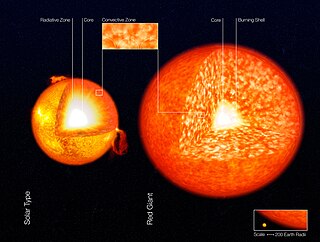
A convection zone, convective zone or convective region of a star is a layer which is unstable due to convection. Energy is primarily or partially transported by convection in such a region. In a radiation zone, energy is transported by radiation and conduction.

RV Tauri variables are luminous variable stars that have distinctive light variations with alternating deep and shallow minima.

R Hydrae, abbreviated R Hya, is a single star in the equatorial constellation of Hydra, about 2.7° to the east of Gamma Hydrae. It is a Mira-type variable that ranges in apparent visual magnitude from 3.5 down to 10.9 over a period of 389 days. At maximum brightness the star can be seen with the naked eye, while at minimum a telescope of at least 5 cm is needed. This star is located at a distance of approximately 410 light-years from the Sun based on parallax measurements, but is drifting closer with a radial velocity of −10 km/s.

Mu1 Cancri, Latinised from μ1 Cancri, is a variable star in the zodiac constellation of Cancer. The name Mu1 comes from the Bayer naming system: the "1" in the name is because (from Earth) it appears to be close to 10 Cancri, or Mu2 Cancri. It is also known by the variable star designation BL Cancri. The star is dimly visible to the naked eye with an apparent visual magnitude that ranges from 5.87 down to 6.07. Parallax measurements put it about 630 light-years (192 parsecs) from the Sun. At that distance, the visual magnitude is diminished by an extinction factor of 0.28. The position of the star near the ecliptic means it is subject to lunar occultations.
27 Cancri is a single star in the zodiac constellation of Cancer, located around 990 light-years away from the Sun. It is visible to the naked eye as a faint, red-hued star with a typical apparent visual magnitude of around +5.56. The star is moving closer to the Earth with a heliocentric radial velocity of −8.3 km/s. It is a member of the Arcturus stream, a group of stars with high proper motion and metal-poor properties thought to be the remnants of a small galaxy consumed by the Milky Way.
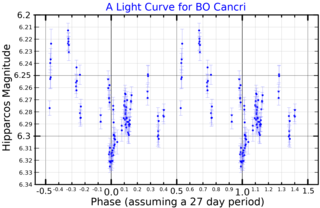
53 Cancri is a variable star in the zodiac constellation Cancer, located around 960 light years from the Sun. It has the variable star designation BO Cancri; 53 Cancri is the Flamsteed designation. This object is a challenge to view with the naked eye, having an apparent visual magnitude around 6. It is around 960 light years away.
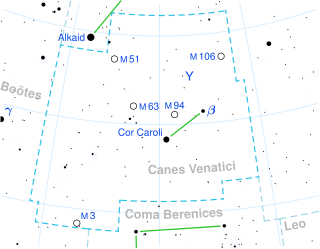
La Superba is a strikingly red giant star in the constellation Canes Venatici. It is a carbon star and semiregular variable.

R Andromedae is a Mira-type variable star in the constellation Andromeda. Its spectral class is type S because it shows absorption bands of zirconium monoxide (ZrO) in its spectrum. It was among the stars found by Paul Merrill to show absorption lines of the unstable element technetium, establishing that nucleosynthesis must be occurring in stars. The SH molecule was found for the first time outside earth in the atmosphere of this star. The star is losing mass due to stellar winds at a rate of 1.09×10−6M☉/yr.

An S-type star is a cool giant with approximately equal quantities of carbon and oxygen in its atmosphere. The class was originally defined in 1922 by Paul Merrill for stars with unusual absorption lines and molecular bands now known to be due to s-process elements. The bands of zirconium monoxide (ZrO) are a defining feature of the S stars.

TX Piscium is a variable red giant star in the constellation Pisces. It is amongst the reddest naked eye stars, with a significant reddish hue when seen in binoculars. It is approximately 800 light years from Earth.

A red giant is a luminous giant star of low or intermediate mass in a late phase of stellar evolution. The outer atmosphere is inflated and tenuous, making the radius large and the surface temperature around 5,000 K or lower. The appearance of the red giant is from yellow-white to reddish-orange, including the spectral types K and M, sometimes G, but also class S stars and most carbon stars.
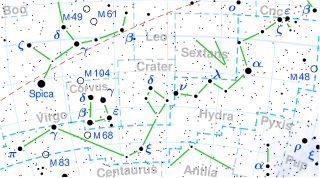
V Hydrae is a carbon star in the constellation Hydra. To date perhaps uniquely in our galaxy it has plasma ejections/eruptions on a grand scale every 8.5 years caused by its near, unseen companion in an 8.5 year orbit, inferred by its ultraviolet excess and periastron passage likely through the outer parts of the star itself.
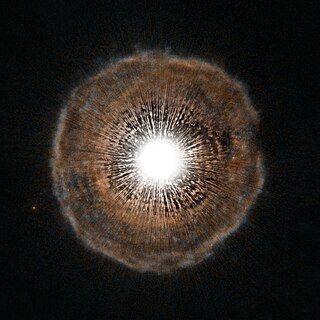
U Camelopardalis is a semiregular variable star in the constellation Camelopardalis. Based on parallax measurements made by the Hipparcos spacecraft, it is located about 3,000 light-years away from the Earth. Its apparent visual magnitude is about 8, which is dim enough that it cannot be seen with the unaided eye.

U Hydrae is a single star in the equatorial constellation of Hydra, near the northern constellation border with Sextans. It is a semiregular variable star of sub-type SRb, with its brightness ranging from visual magnitude (V) 4.7 to 5.2 over a 450-day period, with some irregularity. This object is located at a distance of approximately 680 light years from the Sun based on parallax. It is drifting closer with a radial velocity of −26 km/s.
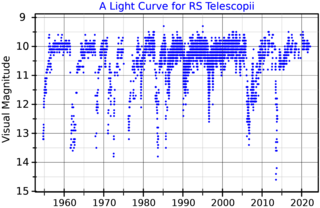
RS Telescopii, abbreviated RS Tel, is a variable star in the southern constellation of Telescopium. It is a dim star with an apparent visual magnitude of 10.67, which is much too faint to be visible without a telescope. The variability of this star was discovered by Evelyn F. Leland and announced by Edward C. Pickering in 1910. It was first studied by Cecilia H. Payne in 1928 at the Harvard College Observatory.
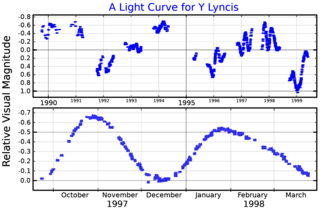
Y Lyncis is a semiregular variable star in the constellation Lynx. It is an asymptotic giant branch star of spectral type M6S, with a luminosity class of Ib, indicating a supergiant luminosity. It is around 1,160 light years away.
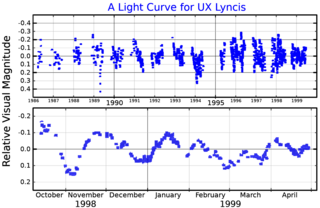
UX Lyncis is a variable star in the faint northern constellation of Lynx, positioned about 3° to the south of the 4th magnitude star 10 Ursae Majoris. This is a red-hued star near the lower threshold of visibility to the naked eye, having an apparent visual magnitude that fluctuates around 6.70. It is located at a distance of approximately 900 light years from the Sun based on parallax, and is drifting further away with a radial velocity of +39 km/s.

TW Horologii is a carbon star and semiregular variable in the southern constellation of Horologium, near the eastern constellation border with Reticulum. It has a ruddy hue and, with an apparent visual magnitude that ranges from 5.52 down to 5.95, is visible to the naked eye and one of the brightest carbon stars. Based on parallax measurements, it is located at a distance of approximately 1,370 light years from the Sun. It is drifting further away with a radial velocity of +14 km/s. In the past this star has been considered a member of the open cluster NGC 1252, but this now seems unlikely.

RS Cancri, also known as HR 3639 and HD 78712, is a star about 490 light years from the Earth in the constellation Cancer. It is a semiregular variable star, ranging in brightness from magnitude 5.4 to 7.3 over a period of about 229 days. During the time intervals when it is brighter than magnitude 6, it may be faintly visible to the naked eye of an observer far from city lights.
References
- 1 2 S. Paul W. Merrill (1952). "Spectroscopic Observations of Stars of Class S". The Astrophysical Journal. 116: 21. Bibcode:1952ApJ...116...21M. doi: 10.1086/145589 .
- ↑ T. Lebzelter & J. Hron. (2003). "Technetium and the third dredge up in AGB stars. I. Field stars". Astronomy & Astrophysics. 411 (3): 533–542. arXiv: astro-ph/0310018v1 . Bibcode:2003A&A...411..533L. doi:10.1051/0004-6361:20031458. S2CID 18879265.
- ↑ Uttenthaler, S.; et al. (February 2007). "Technetium and the third dredge up in AGB stars. II. Bulge stars". Astronomy and Astrophysics. 463 (1): 251–259. arXiv: astro-ph/0610500 . Bibcode:2007A&A...463..251U. doi:10.1051/0004-6361:20065463.
- ↑ Lebzelter, T.; Hron, J. (2003). "Technetium and the third dredge up in AGB stars. I. Field stars". Astronomy and Astrophysics. 411 (3): 533–542. arXiv: astro-ph/0310018 . Bibcode:2003A&A...411..533L. doi:10.1051/0004-6361:20031458. S2CID 18879265.